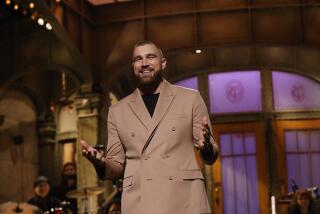It’s what happens away from cameras that works for NFL
- Share via
There are 2,000 or so players in the NFL. Most of them really are decent guys.
But you already knew that. So do the rest of the people who buy the tickets, trinkets and TV packages that make it possible for nearly all of those players to live in the lap of luxury. What somebody at league headquarters should have figured out is that now might not be the best time to remind us.
Nothing, after all, draws attention to a problem faster than pointing out that you don’t really have one.
The NFL’s latest effort at damage control launched Thursday as an online and television campaign centered on a handful of stars calling mom and reading to their kids. Depending on your take, the timing couldn’t have been better -- or worse. For the record, it’s worth noting that the spots were conceived in January and filmed just ahead of training camp -- before the words “Michael Vick” and “dogfighting” were tethered to the league’s image like a leash.
But that’s the problem with news. It breaks when you least expect it, let alone want it. And if the NFL top brass felt strongly enough to throw a quarter of their total ad dollars at what was perceived as a problem last winter, imagine how they must feel now.
“We started with the idea of trying to show our players in a different light, one you wouldn’t otherwise see during the course of a season,” NFL spokesman Brian McCarthy said Thursday.
He noted the league has done similar promotional spots featuring players for as long as it has been around.
“The campaigns are cyclical. We’ve had promotional spots that play off the X’s and Os, the passion on the field, or the celebrations afterward. I could see people making the argument -- ‘Why promote the good guys now?’ -- if we didn’t have 30 or 40 solid years of doing all those things.”
In one sense, he’s right. Among the sports leagues, the NFL wrote the book on being proactive.
The last time the league found itself feeling like a bystander during a crime spree was 2000. During the same week in May 2000, one player sat in an Atlanta courtroom awaiting jury selection in a murder trial, another was charged in Wisconsin with sexually assaulting his 17-year-old baby sitter, and a third, former Carolina Panther Rae Carruth, was ordered by a judge to sell his home and liquidate his NFL retirement account to pay child-support for a son whose mother he helped kill.
But at a rickety old stadium on Chicago’s far South Side, the NFL already was hard at work with a grass-roots effort to shore up the brand. There, a coach named Frank Lenti, who’d built an inner-city Catholic high school into one of the nation’s premier prep dynasties, was running a free youth clinic, one of dozens the league was financing all over the map.
Everybody for miles around not only knew that Lenti had won six state titles by then, but also had turned out NFL stars Donovan McNabb and Simeon Rice. He answered every question thrown at him -- “My guess is everybody who watches TV, reads a newspaper or listens to the radio knows about that stuff,” Lenti said -- without ducking. Once he had commanded their attention about how to play the game, deftly tucked into the same lesson plans were the virtues the game teaches -- teamwork, discipline, responsibility and respect -- and how valuable they were in dealing with problems away from the field, too.
Frankly, for all the eyeballs the NFL’s latest ad campaign will reach, it’s hard to imagine it will touch as many people as Lenti did in a single afternoon. And to be fair, Commissioner Roger Goodell has been even more effective at swaying public perception.
More to Read
Go beyond the scoreboard
Get the latest on L.A.'s teams in the daily Sports Report newsletter.
You may occasionally receive promotional content from the Los Angeles Times.










